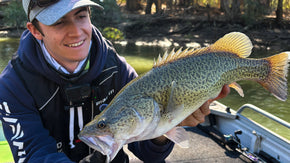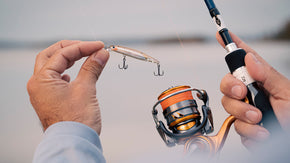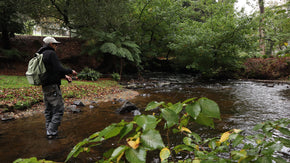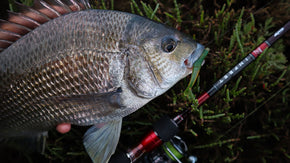Posted 06th January 2023
Landbased Series: Melbourne Region


By Robert Thornton
Boating is a very popular activity throughout Victoria, and particularly in the Port Phillip Bay region. Throughout the year the numbers on the bay fluctuate, but every spring (after the ALF season has ended) thousands of boaties launch their vessels into Port Phillip Bay to enjoy this unique body of water, with a good portion aiming to secure themselves a feed of fresh fish.
Boats are useful tool for fishing in this part of the world, but far from necessary. Victoria boasts some of the best fishing-specific infrastructure in Australia, not just for boaties, but for those on the shore as well. Landbased anglers can enjoy easy access to countless piers, fishing platforms and stocked ponds and lakes. This is all thanks to thoughtful government spending of fishing license revenue.
Initiatives that aim to increase fishing participation in Victoria have contributed to creating facilities that encourage landbased angling, and Victoria should be seen as an example of other states that are lagging with their approach to fisheries management.
Melbournians and Port Phillip residents are particularly lucky, because this body of water has formed in a way that promotes a huge diversity of species.
“The Yarra River provides every fish in Port Phillip Bay with an estuary system,” says Melbourne-based angler Jesse Rotin, “there is a constant inflow of freshwater, and many species come into bay because of that freshwater.”
The Yarra is one of the few major systems in the region that remains open to the ocean all year round, and for species that need a ratio of fresh water to complete their breeding cycle, the reliable Yarra is their life blood. The river itself also supports a healthy range of estuary species, as well as native and introduced freshwater species in its upper reaches.
This bustling southern metropolis has just about everything a landbased angler could want, so let’s take a more in depth look at Melbourne, its species and the landbased fishing spots it has to offer!
 Landbased Kit
Landbased Kit
Melbourne might have a lot of different fish species to target, but when you’re fishing on foot you only have so much carrying capacity. A car is a useful tool for not only transportation, but also extra gear storage, however you need to think about what you can carry on you once you’re out of the car.
Daiwa’s Guide Waist Bag and Sling Bag are good lightweight storage options for anglers wanting to keep their kit compact. These bags are designed specifically for landbased anglers, and are affordable and built to last.
The Egi Wallet and Soft Plastic Wallet are designed to store squid jigs and soft plastics respectively, and it just happens that soft plastics and squid jigs are two of the most effective artificial presentations in the bay! These wallets fit nicely into most bags, and will keep your jigs and soft plastics from tangling and getting mixed up. You don’t want to be mucking around and untangling lures when there’s a hot bite, believe me!
The Guide Backpack would be a great investment for someone looking to carry kit for a few different species or techniques. This pack allows you to store more gear, and can even be worn with the Guide Waist Bag and Guide Phone Pouch in a combined bag-on-bag system for extra storage!
Daiwa’s range of tackle storage and luggage were designed with landbased anglers in mind, so make sure you check out their full range here.
Landbased Tackle
Selecting good all-round tackle for the Melbourne region, as with anywhere, should be based on the species you wish to target, most beginners chasing smaller species should be able to keep it simple, though.
“You can’t really go wrong with a 2-4kg spin outfit with a 2500-3000 size reel, 8-10lb braid and the same in leader,” Jesse says, “This covers pretty much anything, like squid, snapper, salmon, bream, trout, redfin and so on.”
A lightweight spin outfit is suitable for most of the landbased fishing available in Port Phillip Bay, however larger snapper, mulloway, kingfish and salmon might push this gear to its limit. If your goal is to land the bay’s bigger and more challenging fish from the land, upsizing to 3-6kg rods and 3000-4000 size reels is a good idea.
Spin rod series such as the TD Zero, Emeraldas X, or 20 Infeet are high quality but affordable ranges from Daiwa, and offer models in these weights. These rods are designed to suit multiple techniques, and are perfect for someone chasing a few different species. As with most landbased work, opting for slightly longer rods in the 7-8ft range is a good idea, and will make getting a good cast out from the bank or pier far easier. Anyone wishing to specifically target pelagics like tailor, salmon and kingfish from the bank might benefit from using an even longer rod like the Over There range. These rods are designed for landbased anglers targeting pelagics off headlands, beaches, breakwalls and piers, and are perfect for anyone prioritising casting distance.
Mid-ranging spin reels such as the BG, 22 Infeet X, and 20 Emereldas X LT are all great options for a landbased angler wanting something that is reliable, versatile and built to last.
Mainline and leaders are important to think about. While targeting smaller species you want to keep it light and stealthy, with 8-10lb being suitable for braid and leader. Going up to 15lb or heavier may be necessary if your plan is to chase the larger predators in the bay, however.
 Lures and Bait
Lures and Bait
You might think that covering all your bases in such a diverse fishery would be hard, but you’d be surprised what you can catch on just a few simple presentations.
“Soft plastics are by far the most effective lures,” Jesse explains, “they can be fished at any depth and in any terrain.”
“The 2.5 Bait Junkie Minnows are my favourites in the fresh, estuary and salt,” he continues, “any lures that imitate whitebait or smelt are great – 2.5 Grubs are useful as well.”
The Double Clutch range are another one of Jesse’s ‘all-rounders’, both for salt and freshwater.
“I like both the 60 and 75 Double Clutches in natural colours,” he says.
The landbased squidding on offer in Port Phillip Bay is world-class, so you’d be mad not to have a few jigs with you at all times.
“I like to keep a mix of colours and sizes,” Jesse explains, “but I find anything in the 3.0 size will cover you in most situations.”
Larger lures such as the Bait Junkie 5 Inch Jerkshad and Shore Spartan Break Through might be handy additions if chasing bigger snapper, salmon, tailor or mulloway, but these species will take smaller lures as well.
Bait anglers will find there is plenty on offer for them as well, with small species such as gar, King George Whiting, pinkie snapper and bream responding to baits of squid, pilchard, pipis, prawn and sandworm.
Larger targets like snapper, mulloway and gummy sharks will prefer larger dead baits like squid heads, salmon strips and whole dead gar.
 Melbourne/Port Phillip Fishing Spots
Melbourne/Port Phillip Fishing Spots
The Port Phillip Bay area is set up better for landbased anglers than many other cities, so pretty much wherever you go around the bay, there should be something safe to fish from. Piers, beaches, headlands, jetties and walkways all make good fishing platforms, and there’s no shortage of any of these in Port Phillip Bay.
Yarra River Mouth
The entrance to the Yarra around Williamstown Boat Ramp is a great area with plenty of viable fishing platforms for landbased anglers. Because this is the main river system flowing into Port Phillip Bay, lots of different species will move through this area.
“Around the boat ramp there are two breakwaters that lead out into entrance of river,” Jesse explains, “and the nearby channels hold bream, snapper, whiting and mullet.”
“There isn’t as many squid in this area, as the water is a bit murky, but some of the nearby rock walls and piers do hold squid at times.”
“Salmon and tailor will also come into this area in winter, and casting lures off the breakwaters is a good way to catch them.”
A little further up, the Yarra and Maribyrnong rivers in the city hold bream, mulloway and snapper, and both rivers have plenty of riverside access.
Ballerine Peninsula
Down toward the southern end of the bay, regular inflows of clean ocean water provide anglers access to a few other species.
“Around Queenscliff you’ll find more calamari, whiting and silver trevally,” Jesse says, “Boat moorings are good structure for these fish, as well as the main pier at Queenscliff, which is a well-known fishing spot.”
Anglers chasing ocean speedsters will find this area more to their liking as well.
“The closer you get to bottom of the bay, the better it is for pelagics like trevally, salmon and kingfish,” Jesse says, “Point Lonsdale Pier – which is the last pier before the entrance to the bay – is a good spot to try.”
“Picking warmer days seems to be the way to go here.”
“There’s also good snapper in this area at times,” he adds.
Werribee Area
Heading over to the northwest side of the bay, anglers chasing larger estuary species have plenty of options.
“Wyndham Harbour in Werribee South is good area to catch mulloway and snapper,” Jesse says, “The outer breakwalls that cover the harbour are good areas to flick plastics.”
Landbased anglers will find this area is littered with areas to walk and cast lures. Smaller species such as bream, whiting and calamari also frequent the area, and offer a good fallback if the action on the larger predators doesn’t eventuate.
 Melbourne Freshwater
Melbourne Freshwater
Anglers chasing freshwater action are not forgotten about. In fact, there exists quality freshwater fisheries within the city itself!
“Albert Park Lake is stocked with estuary perch, trout and golden perch, and is within the city limits,” Jesse explains, “Access is very good, as there’s a pathway around the whole lake.”
“The lake is shallow with a lot of weed, with little jetties you can fish off,” he continues, “Small, light soft plastics like a 2.5 inch Grub or Minnow work really well in here.”
The upper Yarra can also turn on some great fishing, with any of the freshwater stretches good places to try for a variety of species.
“There’s plenty of fish in the fresh, but access is a bit up and down,” Jesse says, “the area can become really overgrown and this makes it difficult to get down to the water.”
The freshwater stretches holds Murray cod, yellowbelly, Macquarie perch, silver perch, redfin, trout and other introduced species, some of which were not officially stocked.
Adventurous anglers looking for a few stream trout can find them within an hour of Melbourne’s CBD, they just need to look further up the Yarra! Baits of scrubworm are very effective for trout anywhere, but lures such as small soft plastics, bladed spinners and hardbodies will also turns the heads of the local trout.
Wrap Up
It’s no surprise that the capital city of a state that has invested heavily into its recreational fishery has many great landbased fishing options! Even some of the most densely populated areas have viable fisheries that anyone holding a Victorian fishing licence can access and fish.
Of course, there are many other awesome spots to fish from around the bay, and to experience them all would take years!
If you’re a Port Phillip Bay local looking to get into fishing, just remember that you don’t need a boat, and you don’t need to go far!















